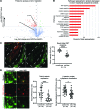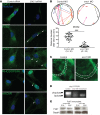Disrupted ER membrane protein complex-mediated topogenesis drives congenital neural crest defects
- PMID: 31904590
- PMCID: PMC6994125
- DOI: 10.1172/JCI129308
Disrupted ER membrane protein complex-mediated topogenesis drives congenital neural crest defects
Abstract
Multipass membrane proteins have a myriad of functions, including transduction of cell-cell signals, ion transport, and photoreception. Insertion of these proteins into the membrane depends on the endoplasmic reticulum (ER) membrane protein complex (EMC). Recently, birth defects have been observed in patients with variants in the gene encoding a member of this complex, EMC1. Patient phenotypes include congenital heart disease, craniofacial malformations, and neurodevelopmental disease. However, a molecular connection between EMC1 and these birth defects is lacking. Using Xenopus, we identified defects in neural crest cells (NCCs) upon emc1 depletion. We then used unbiased proteomics and discovered a critical role for emc1 in WNT signaling. Consistent with this, readouts of WNT signaling and Frizzled (Fzd) levels were reduced in emc1-depleted embryos, while NCC defects could be rescued with β-catenin. Interestingly, other transmembrane proteins were mislocalized upon emc1 depletion, providing insight into additional patient phenotypes. To translate our findings back to humans, we found that EMC1 was necessary for human NCC development in vitro. Finally, we tested patient variants in our Xenopus model and found the majority to be loss-of-function alleles. Our findings define molecular mechanisms whereby EMC1 dysfunction causes disease phenotypes through dysfunctional multipass membrane protein topogenesis.
Keywords: Cardiovascular disease; Development; Embryonic development; Genetics; Monogenic diseases.
Conflict of interest statement
Figures







Similar articles
-
Expanding EMC foldopathies: Topogenesis deficits alter the neural crest.Genesis. 2023 Sep;61(5):e23520. doi: 10.1002/dvg.23520. Epub 2023 Jun 15. Genesis. 2023. PMID: 37318954 Free PMC article.
-
Defective EMC1 drives abnormal retinal angiogenesis via Wnt/β-catenin signaling and may be associated with the pathogenesis of familial exudative vitreoretinopathy.Genes Dis. 2022 Oct 11;10(6):2572-2585. doi: 10.1016/j.gendis.2022.10.003. eCollection 2023 Nov. Genes Dis. 2022. PMID: 37554197 Free PMC article.
-
Deletion of Emc1 in photoreceptor cells causes retinal degeneration in mice.FEBS J. 2023 Sep;290(17):4356-4370. doi: 10.1111/febs.16807. Epub 2023 May 19. FEBS J. 2023. PMID: 37098815
-
Protein transport into the human ER and related diseases, Sec61-channelopathies.Biochem Cell Biol. 2014 Dec;92(6):499-509. doi: 10.1139/bcb-2014-0043. Epub 2014 May 27. Biochem Cell Biol. 2014. PMID: 24934166 Review.
-
ER membrane complex (EMC): Structure, functions, and roles in diseases.FASEB J. 2024 Mar 31;38(6):e23539. doi: 10.1096/fj.202302266R. FASEB J. 2024. PMID: 38498340 Review.
Cited by
-
The endoplasmic reticulum membrane protein complex subunit Emc6 is essential for rhodopsin localization and photoreceptor cell survival.Genes Dis. 2023 May 23;11(2):1035-1049. doi: 10.1016/j.gendis.2023.03.033. eCollection 2024 Mar. Genes Dis. 2023. PMID: 37692493 Free PMC article.
-
De novo variants in EMC1 lead to neurodevelopmental delay and cerebellar degeneration and affect glial function in Drosophila.Hum Mol Genet. 2022 Sep 29;31(19):3231-3244. doi: 10.1093/hmg/ddac053. Hum Mol Genet. 2022. PMID: 35234901 Free PMC article.
-
The ER membrane protein complex subunit Emc3 controls angiogenesis via the FZD4/WNT signaling axis.Sci China Life Sci. 2021 Nov;64(11):1868-1883. doi: 10.1007/s11427-021-1941-7. Epub 2021 Jun 10. Sci China Life Sci. 2021. PMID: 34128175
-
Structural insights into human EMC and its interaction with VDAC.Aging (Albany NY). 2024 Mar 15;16(6):5501-5525. doi: 10.18632/aging.205660. Epub 2024 Mar 15. Aging (Albany NY). 2024. PMID: 38517390 Free PMC article.
-
Exploiting fly models to investigate rare human neurological disorders.Neural Regen Res. 2025 Jan 1;20(1):21-28. doi: 10.4103/NRR.NRR-D-23-01847. Epub 2024 Apr 3. Neural Regen Res. 2025. PMID: 38767473 Free PMC article.
References
Publication types
MeSH terms
Substances
Grants and funding
LinkOut - more resources
Full Text Sources
Molecular Biology Databases
Research Materials

